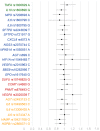Common Inflammation-Related Candidate Gene Variants and Acute Kidney Injury in 2647 Critically Ill Finnish Patients
- PMID: 30862128
- PMCID: PMC6463106
- DOI: 10.3390/jcm8030342
Common Inflammation-Related Candidate Gene Variants and Acute Kidney Injury in 2647 Critically Ill Finnish Patients
Abstract
Acute kidney injury (AKI) is a syndrome with high incidence among the critically ill. Because the clinical variables and currently used biomarkers have failed to predict the individual susceptibility to AKI, candidate gene variants for the trait have been studied. Studies about genetic predisposition to AKI have been mainly underpowered and of moderate quality. We report the association study of 27 genetic variants in a cohort of Finnish critically ill patients, focusing on the replication of associations detected with variants in genes related to inflammation, cell survival, or circulation. In this prospective, observational Finnish Acute Kidney Injury (FINNAKI) study, 2647 patients without chronic kidney disease were genotyped. We defined AKI according to Kidney Disease: Improving Global Outcomes (KDIGO) criteria. We compared severe AKI (Stages 2 and 3, n = 625) to controls (Stage 0, n = 1582). For genotyping we used iPLEXTM Assay (Agena Bioscience). We performed the association analyses with PLINK software, using an additive genetic model in logistic regression. Despite the numerous, although contradictory, studies about association between polymorphisms rs1800629 in TNFA and rs1800896 in IL10 and AKI, we found no association (odds ratios 1.06 (95% CI 0.89⁻1.28, p = 0.51) and 0.92 (95% CI 0.80⁻1.05, p = 0.20), respectively). Adjusting for confounders did not change the results. To conclude, we could not confirm the associations reported in previous studies in a cohort of critically ill patients.
Keywords: acute kidney injury; genetic variation; human genetics.
Conflict of interest statement
The authors declare no conflict of interest. The founding sponsors had no role in the design of the study; in the collection, analyses, or interpretation of data; in the writing of the manuscript, and in the decision to publish the results.
Figures


References
-
- Nisula S., Kaukonen K.-M.M., Vaara S.T., Korhonen A.-M.M., Poukkanen M., Karlsson S., Haapio M., Inkinen O., Parviainen I., Suojaranta-Ylinen R., et al. Incidence, risk factors and 90-day mortality of patients with acute kidney injury in Finnish intensive care units: The FINNAKI study. Intensive Care Med. 2013;39:420–428. doi: 10.1007/s00134-012-2796-5. - DOI - PubMed
-
- Hoste E.A.J., Bagshaw S.M., Bellomo R., Cely C.M., Colman R., Cruz D.N., Edipidis K., Forni L.G., Gomersall C.D., Govil D., et al. Epidemiology of acute kidney injury in critically ill patients: The multinational AKI-EPI study. Intensive Care Med. 2015;41:1411–1423. doi: 10.1007/s00134-015-3934-7. - DOI - PubMed
-
- Kidney Disease: Improving Global Outcomes (KDIGO) Acute Kidney Injury Work Group KDIGO Clinical Practice Guideline for Acute Kidney Injury. Kidney Int. Suppl. 2012;2:1–138.
-
- Bone R.C., Balk R.A., Cerra F.B., Dellinger R.P., Fein A.M., Knaus W.A., Schein R.M., Sibbald W.J. Definitions for sepsis and organ failure and guidelines for the use of innovative therapies in sepsis. The ACCP/SCCM consensus conference. Chest J. 1992;101:1644–1655. doi: 10.1378/chest.101.6.1644. - DOI - PubMed
Grants and funding
LinkOut - more resources
Full Text Sources

